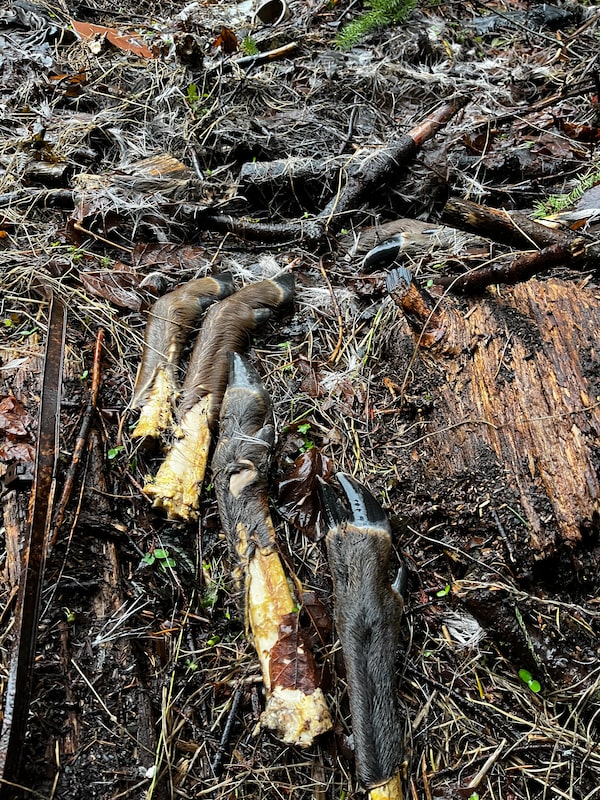Stumps are all that remain of these poached western red cedars on Mount Prevost in the Municipal Forest Reserve of North Cowichan, B.C., on Vancouver Island.Photos courtesy of Larry Pynn
Larry Pynn is a veteran environmental journalist living in Maple Bay, B.C. He publishes the forestry blog, sixmountains.ca.
I’ve long known that unusual experiences await those tempted down remote dead-end roads. But nothing prepared me for the assortment of bizarre, ghoulish and even criminal artifacts I encountered on the logging roads of the Cowichan Valley on Vancouver Island.
I became interested in forest issues soon after moving from Metro Vancouver to Maple Bay in North Cowichan in 2018. I relentlessly roamed the backcountry in my 2005 four-wheel-drive Tacoma pickup, navigating not just the logging main lines, but spearing through a gauntlet of saplings and Scotch broom guarding one dead-end spur road after another. New and often disturbing insights into human behaviour awaited at most every turn in my odyssey.
Debris at the site of an illegal fire in the MFR.
North Cowichan’s 5,000-hectare Municipal Forest Reserve (MFR) – also known as the Six Mountains – is unique in Canada, owned and logged by the municipality. But there is simply not the staff to patrol every stretch of rutted gravel road for illegal activities such as campfires, campsites, littering, poaching and gunplay – especially at night and on weekends.
Through my logging-road patrols, I imagined myself helping to fill an enforcement vacuum. I didn’t make any arrests, but I came close – twice – and my efforts helped lead to an increase in municipal fines for forest offences. I found plenty of crime scenes, including numerous sites where trees, including valuable western red cedars, had been poached.
One winter, I spotted a man in broad daylight sharpening his chainsaw at the back of a rental U-Haul truck, which, I later learned, is a popular vehicle among criminals. I drove past the man, then called RCMP and municipal bylaw enforcement officers. Both showed up within about 15 minutes. I later learned that the man admitted he intended to harvest wood, but hadn’t actually begun to cut. He got off with a warning.
A man sharpens his chainsaw in a rental truck in the MFR, where cutting is not allowed.
Another time in a forest near Ladysmith, to the north, I reported an individual actively cutting wood. The town investigated, told me they caught him in the act, but let him go, too, with a warning.
The illegal harvest of wood is one issue. Leaving behind a mind-bending array of garbage – if one can rightly call it that – is quite another.
At one illegal campsite, I harvested 119 beverage containers, donating them to workers at the local recycling depot. I had fully expected to find cans of Lucky Lager beer, a popular regional swill and familiar ditch-dweller on logging roads. But most were alcoholic iced tea popular with young people.
Elsewhere, I found broken glass, car batteries, clothes, pallets, bicycles, a cement mixer, a ubiquity of motor vehicle parts, including seat springs, tires, rims … and on and on. Shotgun shells from target practice formed a colourful if lumpy ground cover, even next to municipal signs that forbade the activity.

At top, shotgun shells lie near a no-shooting sign; at bottom, deer hooves lie near a no-hunting site near the Chemainus River.
I found the hide of a black bear discarded at one unlawful campsite. Another served as a low-budget, open-air slaughterhouse for black-tailed deer – a grisly pile of hooves, bones and pelts, right next to a toddler’s portable high chair. Use of firearms is prohibited in the area. Close by, in a clearcut devoid of water, sat a 4.2-metre fibreglass pleasure boat sans outboard motor, abandoned.
It got crazier. And pricier.
On a logging spur road, I found the burned-out remains of a fifth-wheel trailer. Had it been stolen, stashed on the site to serve as a meth lab, then caught fire? There are certainly plenty of such cases on the internet. The RCMP chose not to investigate given the absence of a licence plate.
When I drive these logging backroads, I feel I am part of a culture, an unspoken brother and sisterhood. People are friendly, quick to exchange information on directions and road conditions, and helpful if you get in trouble. They don’t seem like bad people, and yet some of them are doing bad things in the backcountry.
It made me wonder: Is this what happens when individuals have no boundaries, no consequences for their actions? Do folks feel entitled to do what they please because it’s public land? Or is there a sense that, “Hey, society has already clearcut the forest, what’s the big deal about what I do?”
The big deal in North Cowichan is that the Municipal Forest Reserve falls within the coastal Douglas-fir forest – one of the most imperilled forest types in Canada, along with Southern Ontario’s Carolinian forest. The Forests Ministry of British Columbia chairs a group of more than 40 conservation groups and all levels of government actively trying to save what’s left of this forest type. North Cowichan is not among them – so far.
A public consultation is under way to see what the public wants for the future of this forest. The University of British Columbia’s forestry department has told North Cowichan council that it stands to make millions of dollars more from carbon credits than continued logging over the next 30 years.
Carbon credits for leaving the trees standing are obviously not an answer for every forest, as we do need wood products. But in North Cowichan, it just might be a way to save a small pocket of endangered forest, and engender a new respect for public lands at the same time.